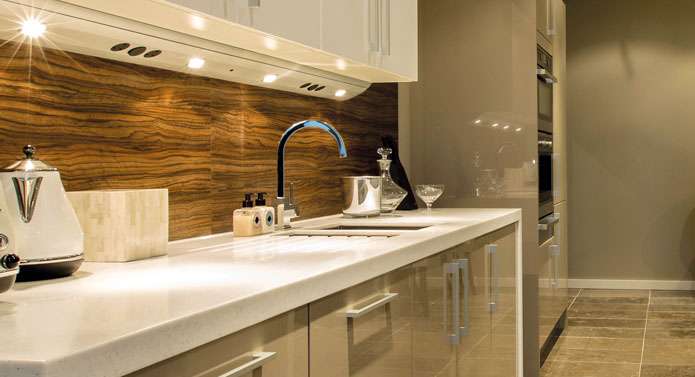Hanging lining paper – Why, When, Where?

Lining paper improves the finish quality and extends the durability of decoration.
Hanging Lining Paper
(Why? When? Where? – But Not How)
For a reliable decorator to hang lining paper in Edinburgh contact HomeForce by phone, 0131 315 0000, email: info@homeforce.co.uk or using the form on this page. All quotations are free of charge and a fair price is guaranteed.
Read on to find out why, when and where you may need to hang lining paper.
In Edinburgh properties is a fairly common to hang lining paper before painting or hanging a finishing paper. This is particularly the case in older tenement properties where lath & plaster walls may be subject to cracking or be far from smooth.
This article explains the benefits of hanging lining paper, situations where using lining paper may be advisable and what lining paper actually is. We also cover what alternatives might be and how much you might expect to pay a decorator to hang lining paper.
Why hang lining paper?
- Smoothness:
- To create a surface that is as smooth as possible for painting or applying a finishing paper to.
- The smoother and flatter a surface is the better the finish will look.
- Cover cracks:
- To disguise or cover hairline cracks.
- In Edinburgh properties the same crack can reappear again and again if it is only filled and sanded. This is particularly the case on lath and plaster walls or plaster on to brick.
- Covering a crack by hanging lining paper will prevent that crack from reappearing so quickly, if ever.
- Reduced contraction of finishing paper:
- Aside from creating a smoother surface for finishing papers a lining paper also holds a finishing paper in shape better than applying it straight to a wall.
- When a wallpaper is pasted it expands due to moisture content. As it dries it contracts and “grips” the wall.
- A lining paper better holds the finishing paper in the expanded shape than a smooth plaster wall and so helps prevent gaps appearing between sheets or even patter distortion..
- Colour leaching:
- As well as expanding the paper the application of paste onto finishing paper can cause some of the colours to leach or “bleed”.
- Hanging a lining paper before the finishing paper speeds up the drying process and by doing so reduces the risk of colour leaching.
- Stain barrier:
- There may be substances in the wall; salts or colorants from materials that have been released due to water ingress.
- A lining paper provides an extra barrier to prevent these marks coming through to the finishing paint or paper.
- Soft colours:
- If applying soft tones or colours onto walls a lining paper provides a more uniform colour to paint onto than a plastered wall.
- Therefore there should not be “unexplainable shades” on the wall.
- Durability:
- A finishing paper applied directly to a bare plastered wall or a painted wall can peel off after drying.
- Hanging a lining paper first will hold the finishing paper in place far better.
- Insulation:
- Perhaps a difficult one to quantify but a layer of lining paper does add a layer of insulation.
- There are in fact “Papers” available specifically designed to provide insulation.
What are the alternatives to hanging lining paper?
Varying thicknesses (“grades” or “gauges”) of lining paper available which are measured in grams per square meter (gsm). The grades most frequently used are 800gsm, 1200gsm or 1400gsm though they are available in grades up to at least 2000 – almost like cardboard.
However, even the thickest paper may not sufficiently cover or camouflage all imperfections, holes and unevenness.
When a wall is in “bad” condition (many holes, gouges, cracks or loose plaster) the most cost effective solution is likely to be to skim plaster it rather than spending hours (or paying a tradesman to spend hours) filling and sanding only to find that lumps and bumps are still visible once lined. A good decorator will advise you of the best course of action. Even after the wall is plastered it may still be recommended to hang lining paper due to the other reasons given above.
If a plasterboard wall has had tiles removed or simply paper stripped it can lead to numerous deep gouges that will be better dealt with by a plasterer than a decorator. In the worst cases fitting new plasterboard and taping the joints may be the lowest cost solution.
What is Lining Paper?
It really is just paper.
Good quality lining paper will be made from 100% wood pulp. Lower quality or budget paper will include some recycled paper. You may think this is better for the environment but bear in mind that bleaches are used in the recycling of paper. Most quality lining paper will be made from renewable / sustainable timber.
How much does it cost to hang lining paper?
Each job will, of course, differ. However, an “average” room (if such a thing exists) with a floor area of around 15 to 20 square meters with 2.5 to 3m high ceilings will usually cost in the region of £180 to £220 (Excluding VAT) to line.
The total cost will be affected by how much preparation – filling and sanding holes – is required before hanging the paper, how many doors and windows are in the room, the presence of picture or dado rails or cornicing and any angles, for example round dorms windows.
If there is existing paper on the walls that is to be removed we’d suggest allowing between £150 to £200, in addition, to strip a room of a similar size.
Please though do take these as ball park costs. We’re very happy to arrange for a formal quotation.
Arrange a quote from a reliable decorator to hang lining paper:
- Complete our Tradesperson Booking Form
- Tel: – 0131 315 0000
- Email: – info@homeforce.co.uk



